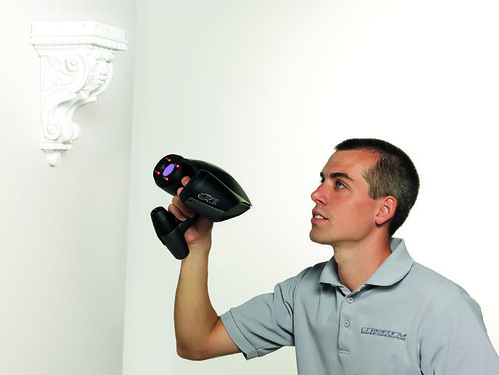There are a number of different devices that are referred to as 3D scanners. The name is given to everything from prodding devices to CT scanners. The objective, however, is always the same: to create a digital 3D model from a real-world object. Modern scanners can detect not only shape, but also color and density. Certain materials cause problems for certain types of scanners; for example, depending on the scanner used, there may be problems with highly reflective or transparent materials.
The 3D models created – as well as the raw data used to generate them – are useful for medical prosthetics, industrial design, movies and video games, and inspection of cultural artifacts, among many other applications.
 source: Creative Tools via Flickr
source: Creative Tools via Flickr
##Free softwares
###123Dcatch
123D Catch is Autodesk’s free solution for converting photographs into 3D models. Photos are uploaded to the Autodesk Cloud where they are processed to create the model. The software uses photogrammetry to attempt to reconstruct the geometries in the scanned object. The models are outputted in 123D’s format, which allows modifying them and setting constraints using 123D: Autodesk’s free, simplified CAD tool for hobbyists. The model can then be sent to a 3D printing service directly from 123D. The software works best with 20-40 photos. Apps are available from the iTunes store for iPhone and iPad (second generation and above), allowing users to directly upload to the cloud from the place where the pictures are taken, if desired. Catch is currently being used to create 3D models of museum pieces.
###My3Dscanner
My3Dscanner is an online service that takes flat pictures as input and produces 3D models as output. The pictures need to be of the same object from several different angles; the more the better. The pictures are uploaded to the company’s server, which creates a point cloud from them and generates the resulting mesh. Point clouds retain color information, allowing each resulting mesh to more closely resemble the object each of them is based on. The mesh is then made available for the user to download, free of charge.
###Trimensional
Trimensional brands itself as “The world’s first 3D scanner for iPhone”. The software is available for the iPhone 4 and iPod Touch 4th generation. The software is specifically designed to capture and model faces exhibiting odd expressions. The screen is used as the camera’s flash allowing the target to be captured in a single shot. Movies can also be captured, resulting in animated 3D models. The software includes a social portion allowing the scanned model to be shared, e-mailed, or sent directly to a 3D printer from the phone. Trimensional requires a dark environment and a high screen brightness setting for best results.
##Professional 3D scanners
###Kinect Fusion
The official way to use the Kinetic sensor to create 3D models, Kinetic Fusion allows scanning objects four meters away. This allows entire rooms to be mapped digitally. The sensor and the object must be moved relative to each other for the capture to generate enough data to create the model. The sensor captures a plethora of individual frames, which it then combines to create the 3D mesh. It is recommended as a professional, cost-effective solution, since it depends on Kinetic sensors (which only cost about $150)
###ReconstructMe
To scan objects using ReconstructMe, the special ReconstructMe sensor must be used on the object desired. The system generates meshes in real time and displays them on screen, allowing the user to easily see what still needs to be scanned. ReconstructMe can be used to scan large areas, such as factories, retaining color detail; thus enabling the scanned meshes to be used for detail digital processing and planning. The product is also sold together with a development kit, allowing the sensor’s real-time reconstruction capabilities to be given other uses.